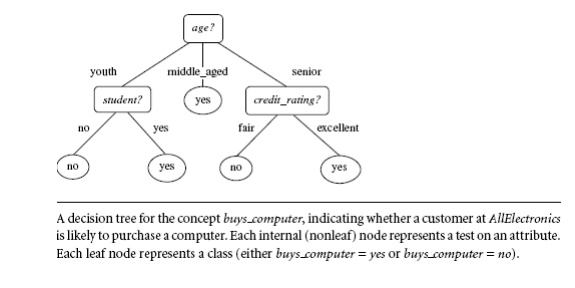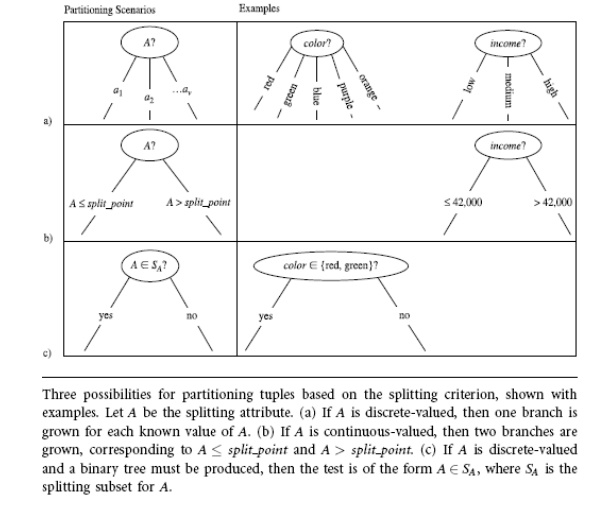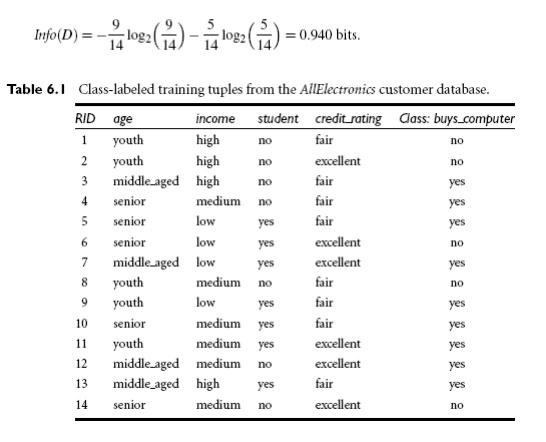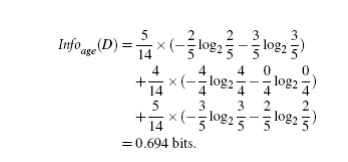Chapter: Data Warehousing and Data Mining : Association Rule Mining and Classification
Classification by Decision Tree Induction
Classification
by Decision Tree Induction
Decision tree
o
A flow-chart-like tree structure
o
Internal node denotes a test on an attribute node
(nonleaf node) denotes a test on an attribute
o
Branch represents an outcome of the test
o
Leaf nodes represent class labels or class
distribution(Terminal node)
o
The topmost node in a tree is the root node.
Decision
tree generation consists of two phases
o
Tree construction
o
At start, all the training examples are at the root
o
Partition examples recursively based on selected
attributes Ø Tree
pruning
o
Identify and remove branches that reflect noise or
outliers

A typical
decision tree is shown in Figure. It represents the concept buys computer, that is, it predicts
whether a customer at AllElectronics
is likely to purchase a computer. Internal nodes are denoted by rectangles, and
leaf nodes are denoted by ovals. Some decision tree algorithms produce only binary trees (where each internal node
branches to exactly two other nodes), whereas others can produce non binary
trees.
“How are decision trees used for
classification?” Given a tuple,
X, for which the associated class label is unknown, the attribute
values of the tuple are tested against the decision tree. A path is traced from
the root to a leaf node, which holds the class prediction for that tuple.
Decision trees can easily be converted to classification rules.
Decision Tree Induction

The tree starts as a single node, N,
representing the training tuples in D
(step 1)
If the tuples in D are all of
the same class, then node N becomes a
leaf and is labeled with that class (steps 2 and 3). Note that steps 4 and 5
are terminating conditions. All of the terminating conditions are explained at
the end of the algorithm.
Otherwise,
the algorithm calls Attribute selection
method to determine the splitting criterion. The splitting criterion tells
us which attribute to test at node N
by determining the ―best‖ way to separate or partition the tuples in D into individual classes(step 6). The
splitting criterion also tells us which branches to grow from node N with respect to the outcomes of the
chosen test. More specifically, the splitting criterion indicates the splitting
attribute and may also indicate either a split-point or a splitting subset. The
splitting criterion is determined so that, ideally, the resulting partitions at
each branch are as ―pure‖ as possible.
A
partition is pure if all of the tuples in it belong to the same class. In other
words, if we were to split up the tuples in D
according to the mutually exclusive outcomes of the splitting criterion, we
hope for the resulting partitions to be as pure as possible.
The node N is labeled with the splitting
criterion, which serves as a test at the node (step 7). A branch is grown from
node N for each of the outcomes of
the splitting criterion. The tuples in D
are partitioned accordingly (steps 10 to 11). There are three possible
scenarios, as illustrated in Figure. Let A
be the splitting attribute. A has v distinct values, {a1, a2, : : : , av}, based on the training data.

Attribute Selection Measures
An
attribute selection measure is a heuristic for selecting the splitting
criterion that ―best‖ separates a given data partition, D, of class-labeled training tuples into individual classes. If we
were to split D into smaller
partitions according to the outcomes of the splitting criterion, If the
splitting attribute is continuous-valued or if we are restricted to binary
trees then, respectively, either a split
point or a splitting subset must
also be determined as part of the splitting criterion This section describes
three popular attribute selection measures—information
gain, gain ratio, and gini inde
Information gain:ID3 uses
information gain as its attribute selection measure.

Information
gain is defined as the difference between the original information requirement
(i.e., based on just the proportion of classes) and the new requirement (i.e.,
obtained after partitioning on A).
That is,

In other
words, Gain(A) tells us how much
would be gained by branching on A. It
is the expected reduction in the information requirement caused by knowing the
value of A. The attribute A with the highest information gain, (Gain(A)),
is chosen as the splitting attribute at node N.
Example Induction
of a decision tree using information gain.
Table 6.1
presents a training set, D, of
class-labeled tuples randomly selected from the AllElectronics customer database. (The data are adapted from
[Qui86]. In this example, each attribute
is discrete-valued. Continuous-valued attributes have been generalized.) The
class label attribute, buys computer,
has two distinct values (namely, {yes,
no}); therefore, there are two distinct classes (that is, m = 2). Let class C1 correspond to yes and
class C2 correspond to no. There are nine tuples of class yes and five tuples of class no. A (root) node N is created for the tuples in D.
To find the splitting criterion for these tuples, we must compute the
information gain of each attribute. We first use Equation (6.1) to compute the
expected information needed to classify a tuple in D:

The
expected information needed to classify a tuple in D if the tuples are partitioned according to age is

Hence,
the gain in information from such a partitioning would be

Similarly,
we can compute Gain(income) = 0.029 bits, Gain(student)
= 0.151 bits, and Gain(credit rating) = 0.048 bits. Because age has the highest information gain
among the attributes, it is selected
as the splitting attribute. Node N is
labeled with age, and branches are
grown for each of the attribute’s values. The tuples are then partitioned
accordingly, as shown in Figure 6.5. Notice that the tuples falling into the
partition for age = middle aged all
belong to the same class. Because they all belong to class “yes,” a leaf should therefore be created at the end of this branch
and labeled with “yes.” The final
decision tree returned by the algorithm is shown in Figure 6.5.

Related Topics